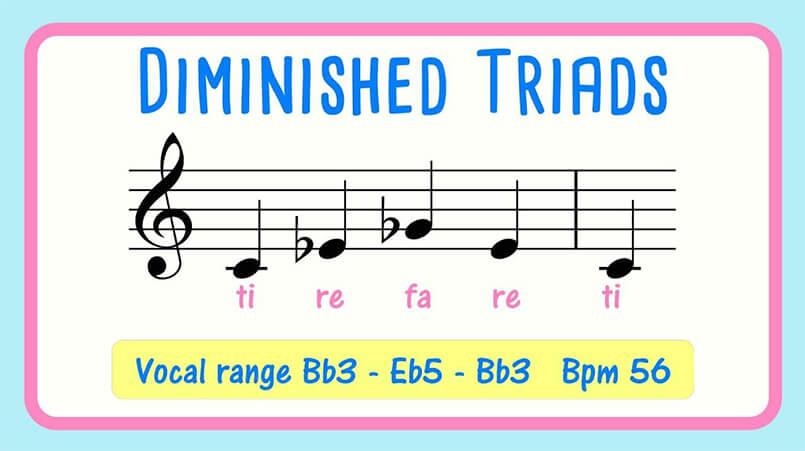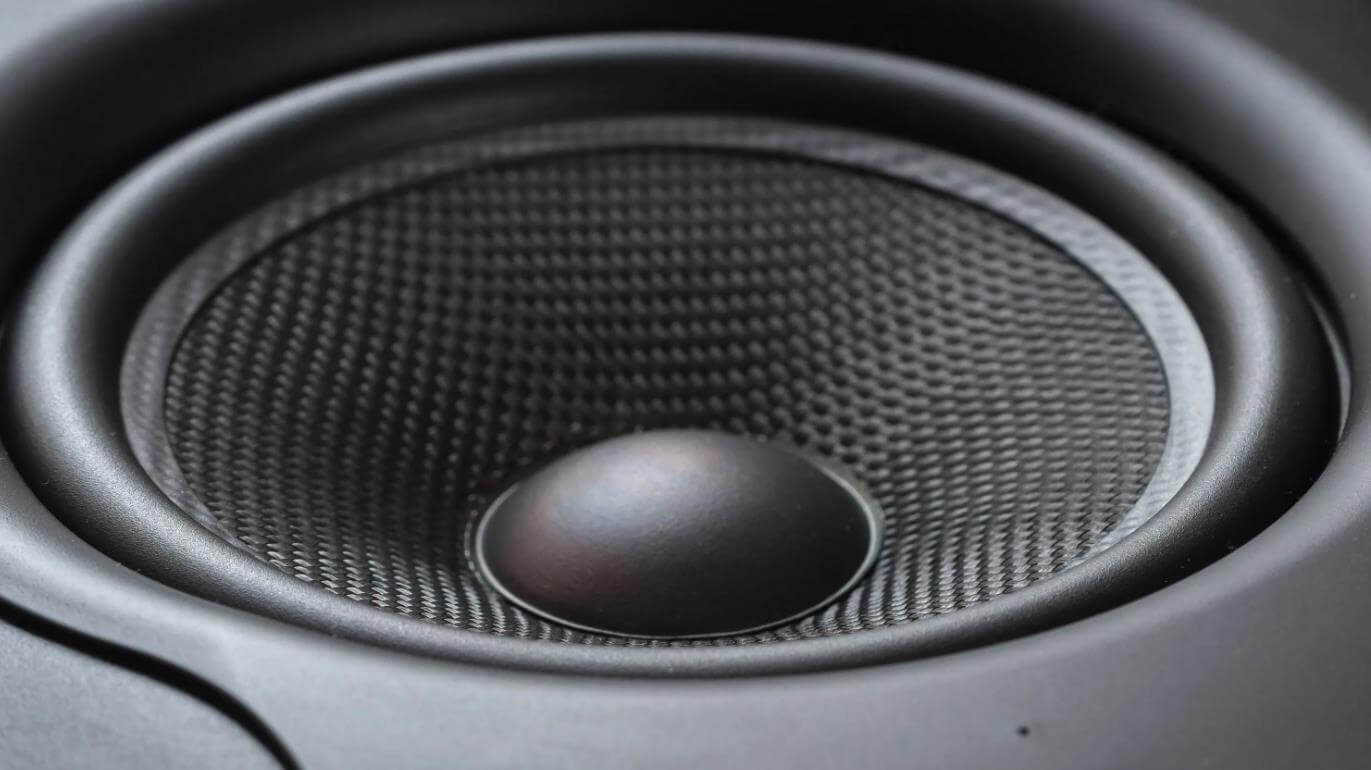Diminished triads

A diminished chord is a triad built from the root, a minor third, and a diminished fifth. This means it consists of two minor thirds stacked above the root, with three half steps between each note in the chord. For example, a regular C major triad has the notes C (root), E (third), and G (fifth). In the diminished version, these notes become C, Eb, and Gb.
Diminished chords bring drama, tension, and suspense to music. They have a dark, dissonant, and slightly eerie quality, making them stand out with a unique sound. The flattened fifth gives the chord an unstable feel that demands resolution, creating a suspended effect and making the return to more consonant chords feel particularly impactful.
In music theory, a diminished triad (sometimes called a minor triad with a lowered fifth) consists of two minor thirds above the root. It is commonly symbolized as “dim,” “o,” “m♭5,” or “MI(♭5).” However, in popular chord notation, “dim” and “o” often represent a diminished seventh chord (a four-note chord), which may also be written as “dim7” or “o7” in jazz and theory texts.
In classical theory, the diminished triad was considered dissonant due to its diminished fifth (or tritone), which heightened the need for resolution and made it an essential tool for adding emotional depth to compositions.
How to make a diminished chord
Diminished chords are simple to construct because the intervals between their notes are evenly spaced, each forming a minor third. This means each note in a diminished chord is three half steps away from the last. Easy, right?
There are three main types of diminished chords: the diminished triad, the diminished seventh chord, and the half-diminished seventh chord. Let’s take a look at how to build each of these in the key of D minor.
1. Diminished triad (DIM OR °)
A diminished triad consists of:
- The root note;
- A minor third;
- A diminished fifth.
This is a minor chord with a lowered fifth, commonly represented by the symbols “dim” or “°” (e.g., Ddim or D°).
To build a diminished triad, start with the root note of the chord—it’s the foundation of the chord. For the Ddim chord, the root note is D.
Next, count three half steps up from the root to find the minor third. In the case of Ddim, the third is F.
Then, count three more half steps from the third (or six half steps from the root) to locate the diminished fifth. For Ddim, this would be Ab.
So, the complete Ddim triad contains the notes: D – F – Ab.
2. The diminished seventh chord (dim7 or °7)
A diminished seventh chord is a four-note chord that includes:
- The root note;
- A minor third;
- A diminished fifth;
- A diminished seventh.
Also known as a fully diminished chord, the diminished seventh chord adds an additional minor third above the triad, creating extra tension. This means the seventh note is three half steps above the diminished fifth.
For example, in the Ddim7 chord, the seventh note is Cb. So, the complete Ddim7 chord consists of the notes: D – F – Ab – Cb.
3. The half-diminished seventh chord (m7b5 or ø7)
A half-diminished seventh chord is a four-note chord that includes:
- The root note;
- A minor third;
- A diminished fifth;
- A minor seventh.
The half-diminished chord adds a minor seventh to the diminished triad, creating a softer tension compared to a fully diminished chord. The seventh note in a half-diminished chord is four half steps above the diminished fifth.
For example, in the Dø7 chord, the seventh note is C. So, the full Dø7 chord consists of the notes: D – F – Ab – C.
Diminished Triads in Major and Minor Scales
In major scales, a diminished triad only appears on the seventh scale degree. For example, in the key of C major, this is the B diminished triad (B, D, F). Since it’s built on the seventh degree, it’s also known as the leading tone triad. This chord has a dominant function, but unlike a dominant triad or dominant seventh chord, it acts more as a prolonging chord than a structural chord, as it lacks the strong fifth-to-root motion.
In natural minor scales, the diminished triad is found on the second degree. In C minor, for instance, this is the D diminished triad (D, F, Ab), commonly known as the diminished supertonic triad. Like the supertonic triad in major keys, it has a predominant function and almost always resolves to a dominant chord.
In minor keys, a diminished triad can also be found on the raised seventh degree, ♯vii°, due to the raised sixth and seventh notes in the ascending melodic minor scale. For example, a common progression would be ♯vii°–i.
Typically, both the leading tone triad and the diminished supertonic triad appear in first inversion (vii°6 and ii°6, respectively), as their structure features a diminished fifth in the bass. This differs from the fully diminished seventh chord, which often appears in root position. In both cases, the bass note resolves upward, while the upper voices move downward in contrary motion.
Diminished Triads in Popular Music
Walter Everett notes that “in rock and pop music, the diminished triad almost always appears on the second scale degree, creating a melancholy and sentimental ii° with the notes 2–4–♭6.” Examples of songs using ii° include “Sleep Walk” by Santo & Johnny, “Cara Mia” by Jay and the Americans, and “The Air That I Breathe” by the Hollies. While this chord isn’t rare, it’s uncommon enough to suggest that rock musicians often consciously avoid it. Instances where it’s used can be found in “Don’t Look Back in Anger” by Oasis, “Space Oddity” by David Bowie, and twice in “Everytime You Go Away” by Daryl Hall.
The vii° chord in major keys is even less common than ii°, but it can still be found in certain progressions. It’s often used to emphasize the relative minor tone, as in progressions like vii°–V7/vi–vi, which resembles the ii°–V7–i structure in the relative minor key.
Tuning Diminished Triads
In twelve-tone equal temperament, a diminished triad has a structure where three half steps separate the third from the fifth, three half steps are between the root and the third, and six half steps lie between the root and the fifth.
In 5-limit just intonation, a diminished triad on the VII degree (for example, in C: B–D–F) has ratios of 15:8, 9:8, and 4:3. For a triad on the II degree (in C: D–F–A♭), the ratios are 9:8, 4:3, and 8:5 (135:160:192). According to Georg Andreas Sorge, a trumpet’s natural overtone series on C produces a diminished triad of E–G–B♭ with a ratio of 5:6:7, referred to as a “perfect diminished chord,” although the 7 is slightly lower than the preferred 45:54:64.
Helmholtz describes the diminished triad as 1 − D | F, providing a combination of a minor third and a Pythagorean minor third with a 45:54:64 ratio, as noted in his notation system in On the Sensations of Tone as a Physiological Basis for the Theory of Music.
How to Use Diminished Chords in Progressions
Diminished chords are often used as passing chords in progressions. They add excitement to standard progressions, creating tension between chords that are more harmonically tied to the key.
A passing chord acts as a bridge between primary chords in the progression. It’s typically outside the main key of the song, which creates a dissonance that needs to resolve to a chord more harmonically aligned with the song’s key.
The most common passing chord is the diminished seventh. Try adding a diminished chord in the middle of your chord sequence, then resolve it to a major or minor chord a half step up. This adds tension and intrigue to the progression while keeping it melodic.
For example, you can replace the V chord in a standard progression with a Dim7 or m7b5 chord. If your progression is I – V – vi – IV, the diminished chord can take the place of the second chord.
However, diminished chords aren’t limited to replacing the V chord. You can use them anywhere in a progression. Due to their unstable sound, though, they’re rarely placed on the first or last beat and are seldom used in succession. Typically, diminished chords appear only briefly, lasting one or two beats, as transitional elements in a progression.
Where to Use Diminished Chords
To decide where to add a passing diminished chord, start by finding two chords a whole step apart. Then, build a diminished chord on the note between them. Finally, place this passing chord between the two whole-step chords.
For example, let’s take the progression C – Am – F – G. The F major and G major chords are a whole step apart. The note between them is F#. Build an F#dim chord and place it between the F and G major chords. The new progression becomes: C – Am – F – F#dim – G.
Diminished Triad Chord Structure
| Chord | Root Note | Minor Third | Diminished Fifth |
|---|---|---|---|
| Cdim | C | E♭ | G♭ |
| C♯dim | C♯ | E | G |
| D♭dim | D♭ | F♭ (E) | A |
| Ddim | D | F | A♭ |
| D♯dim | D♯ | F♯ | A |
| E♭dim | E♭ | G♭ | B♭ |
| Edim | E | G | B♭ |
| Fdim | F | A♭ | C♭ (B) |
| F♯dim | F♯ | A | C |
| G♭dim | G♭ | B♭ | D♭ |
| Gdim | G | B♭ | D♭ |
| G♯dim | G♯ | B | D |
| A♭dim | A♭ | C♭ (B) | E |
| Adim | A | C | E♭ |
| A♯dim | A♯ | C♯ | E |
| B♭dim | B♭ | D♭ | F♭ (E) |
| Bdim | B | D | F |










